Has your computer ever been slow and you couldn’t tell what the problem was? Nowadays, illicit cryptomining can cause those performance problems. It dethroned ransomware as the top cybersecurity threat in 2018. (Webroot Threat Report 2018) A simple website visit can start the mining process as a javascript running in the background of the browser or an accidentally installed malware on your computer. These two examples for different modes of illicit cryptomining are called browser-based cryptojacking and binary-based cryptomining. In both cases hash-rates can be up to medium-sized mining farms. This blog article will give an overview over binary-based cryptomining malware. In that case the mining process is embedded in the payload of a malware. Criminals hide it as good as possible which makes it hard to detect to gain a massive income. All the tools they need to start a malicious cryptomining business are easy to get in underground markets. For example Malware can be purchased for a few dollars (e.g. the average cost for an encrypted miner for Monero XMR is 35$). We will also take a quick look at how companies are legally using cryptomining to monetize web content as an alternative business model.
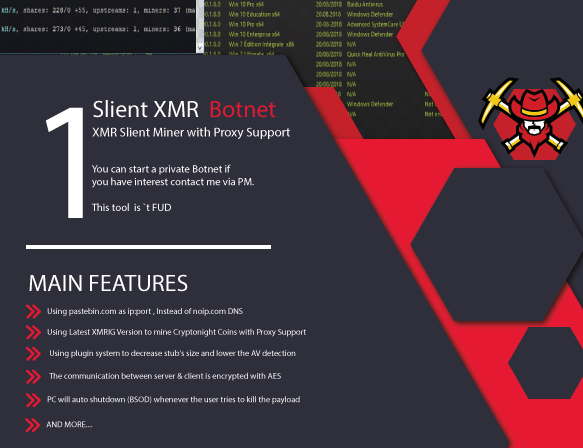
Ecosystem: A Decade of Unrestricted Wealth”
by S.Pastrana and G.Suarez-Tangil
Basics
In this part we will have a look on basics which are required for this article.
Mining Pools
Since more and more computational power is required to calculate cryptocurrencies mining pools are popular. A mining pool is a collection of miners who pooled their resources together to mine a cryptocurrency and share their rewards for every calculated block. But there are advantages and disadvantages of mining pools. One main advantage is a more stable income by using mining pools due better chances to solve a cryptographic puzzle for the next block. On the other hand miners have to share their rewards which can be seen as a disadvantage, but without enough resources the outcome is potentially lower. (Mining Pools and How They Work 2019)
Cryptocurrency Wallets
Cryptocurrency wallets are not exactly like wallets we know from daily life. Users can monitor their balance and send money or execute other operations. The virtual wallets contain a private and public key to perform operations. The keys are used to access the public blockchain adresse and confirm a transaction. The private key is used for the transaction of the wallet owner an the public key is similar to a international Bank Account Number. For example, if someone wants to transfer money to your wallet this person needs your public key, but you don’t get actual money on your account. The transaction is only identified by a transaction record on the blockchain and a balance change in your cryptocurrency wallet. Important to know is that the private key is totally unique and in the case of a lost of it the wallet won’t be accessible anymore for its owner. (What is a wallet 2019)
Binary-based Mining
Binary-based mining is the common way to mine cryptocurrency. Users install a program or application on a device to mine. That would be the legitimately way as the user gets the rewards for accomplished performance. It gets illicitly if a malicious actor gains access to the users computer power through a malware and mines for their own benefits. The mining software would be installed on the computer and drains the CPU performance of the victim and the payments for the rewards are going to the wallet of the attacker.
Browser-based Mining
In addition to the two types of illicit cryptomining we will have a brief look at browser-based cryptojacking. Illicit browser-based mining is continually rising in the past years. As in the introduction mentioned it is really simple to run into it. As long as an user navigates on a website and uses the services the mining process is running. The browser of the victim performs scripts which execute the mining progress. It is only illicit if the user is not aware of it. There are some websites that use this method to generate money legally for maintenance, as donations or as a substitute for advertising. For example the UNICEF organization in Australia used this method to provide donations. (UNICEF Donation 2019)

UNICEF notifies the users about the procedure and started the mining operation after an agreement to the terms on the devices of the users which makes the activity legitimate.
Key Enablers of Illicit Cryptomining
The factors of key enablers of the malicious actors to conduct were analyzed by the cyber threat alliance in 2018 (The illicit Cryptocurrency Mining Threat 2018). Let’s have a look on these factors :
- It’s more profitable since the increased value of cryptocurrencies.
- Cryptocurrencies with anonymity for transactions, such as Monero and Ethereum that can be mined with personal computers or IoT devices and create a potential attack surface.
- Malware and browser-based exploits are easy to use and easily available.
- The number of mining pools is increasing, facilitating the pooling of resources and providing a scalable method for mining.
- Enterprises and individuals with inadequate security measures are targets for malicious actors and are unaware of the potential impact on their infrastructure and operations.
Most popular Cryptocurrency
Since the popularity of Bitcoin dropped for illicit cryptomining over time, because of the increased amount of time to calculate a single coin, underground economies focus other cryptocurrencies like Monero (XMR). Monero is the most popular cryptocurrency for illicit cryptomining, because of the use of innovative ringsturcutres and decoys to retain transactions completely untraceable. (Webroot Threat Report 2019) Researchers found out that 4,32% of the circulating XMR was mined with cryptomining malware which has an estimated revenue of nearly 57 million USD. (First Look 2019)
Damage caused by Cryptomining
Cryptomining can cause serious damage in different ways. It is draining the CPU usage which could be detected easily during the use of an infected computer, but criminals use distinct methods to evade detection of the mining process. These methods will be explained later in the article. Another main damage is the increased power supply of the CPU or GPU which cause high electricity bills. Through the excessive load of computer components during the process the hardware deteriorates rapidly.
How Criminals spread the Malware
The common approach to spread the malware is to host it in public cloud storage sites such as Amazon Web Services (AWS), Dropbox, Google Drive, Github and so on. Criminals often hide the malware in stock mining software for instance xmrig or xmr-stak to get access. Another approach is the use of botnets which are offered as pay-per-install (PPI) services in the deep web markets. (First Look 2019)
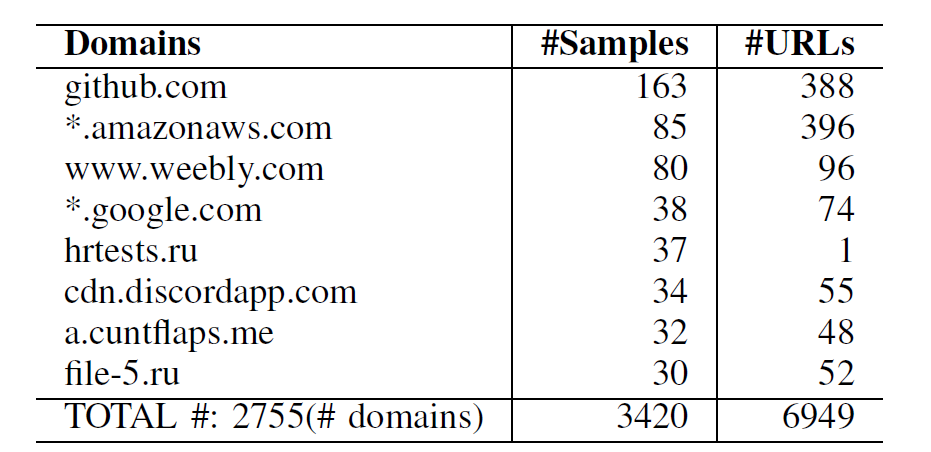
Ecosystem: A Decade of Unrestricted Wealth”
by S.Pastrana and G.Suarez-Tangil
A Further and probably the oldest approach to transfer these executables to a user is to deliver malicious spam or exploit kits by email. The malware starts to infect the computer after opening the attachment. Once the machine installs the malicious mining software it starts to mine cryptocurrency. In some cases the malware begins to scan the network for more accessible devices and tries to infiltrate them with an exploit.
Mechanisms to evade Detection
As earlier mentioned most of the cryptomining malware make use of stealth techniques. The more difficult it is to detect them, the longer the malware can utilize the computing power. The method idle mining starts the mining process only when the computer is in idle state and no operations are running for a certain time. For example if you leave your computer without turning it off for a longer time the mining process starts and lasts as long as there is no interaction with the computer. After an interaction the process shuts down and the performance is free for the user. The programmers of the malware take care in many ways to evade detection. There are cryptomining malwares with different modes for desktop and laptop to get the best computing power for the infected device. For instance the malware on the laptop would take just as much performance as possible to keep the fans quiet. Another technique is the execution stalling code which makes the process almost invisible when Task Manager is running. If the Task Manager is running the mining process is slowing down the CPU utilization. It is possible to bypass this execution stalling code by using other process monitoring applications. Furthermore cryptomining campaigns use domain aliases (e.g. CNAME) to prevent blacklisting of mining pools.
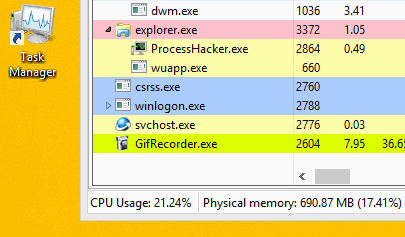
The image above shows how the execution stalling of the malicious miner called Norman works. It is based on a XMRig-based crypto-miner and avoids detection. After the Task Manager opens the malware stops operating and re-injects itself as soon as the Task Manager is closed.

In the figure above we can see another stealth technique which was described by Palo Alto Networks. This cryptomining malware uses only 20 percent of the machines CPU. The benefits of using this method is to persist longer on the infected machine and avoid detection as the mining performance is lower than possible.
Campaigns
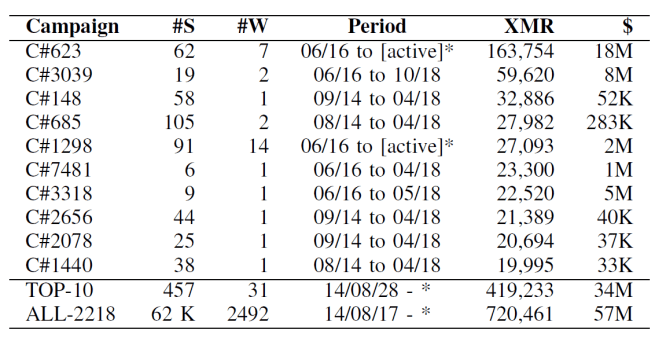
Ecosystem: A Decade of Unrestricted Wealth”
by S.Pastrana and G.Suarez-Tangil
If we have a look on the illicit cryptomining campaigns we see a small number of actors that monopolize the cryptomining malware ecosystem. It is common to see campaigns mining in various pools. The most popular are crypto-pool, dwarfpool and minexmr and there are successful campaigns that are running for over 5 years without getting detected. In the next part we will have a look on the most profitable campaigns which were still active in 2018 and were analysed by Sergio Pastrana of the Carlos III University of Madrid and Guillermo Suarez-Tangil of the King’s College London and which this article is based on.
The Freebuf Campaign
The Freebuff Campaign was and probably is still active since 2016 and has mined over 163K XMR (approx. 18 million USD). It is named “Freebuf” because of the main domain xt.freebuf.info. Statistics of two banned wallets have shown that they were connected from 5,352 and 8,009 different IPs and had mined 362.6 and 1,283.7 XMR. The campaign used 7 wallets which are connected to the mining pools minexmr and crypto-pool by using domain aliases. After the ban of the two wallets the operator changed to another mining pool.

Ecosystem: A Decade of Unrestricted Wealth”
by S.Pastrana and G.Suarez-Tangil
In the figure above we can see the structure of the Freebuf campaign. The green nodes are malware miners and are connected to wallets shown as blue nodes. Gray and pink nodes represent the infrastructure of the campaign. Therefore the gray nodes represent the contacted domain server and the pink node shows the malware hosts. The red and orange nodes symbolize additional malware. As earlier mentioned the campaign uses 7 wallets which we can see in this graph. All the malware miners are connected to one of the wallets and linked to one mining pool which is hidden behind a CNAME alias domain. We can see three different domain servers in this graph: xt.freebuf.info, x.alibuf.com and xmr.honker.info. All of them have been aliases of common used mining pools. For example xt.freebuf.info and xmr.honker.info are aliases for minexmr and x.alibif.com for crypto-pool.
The USA-138 Campaign
The USA-138 has mined at least 6,709 XMR (approx. 651K USD) using 5 wallets. An interesting point about this campaign is it has mined the cryptocurrency Electroneum (ETN) with earnings of 314.18 ETN in late 2018. It was worth less than 5 USD, but it was a speculative for the future.
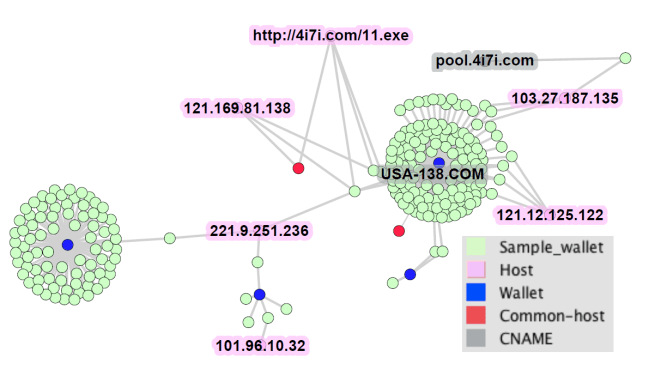
Ecosystem: A Decade of Unrestricted Wealth”
by S.Pastrana and G.Suarez-Tangil
The figure above shows the structure of the USA-138 campaign. The meaning of the nodes are the same as previously described in the Freebuf campaign chapter.
Countermeasures
The simplest method to prevent cryptomining malware is to keep the anti virus updated and avoid to download tools from suspicious websites. Furthermore the operating system should stay updated to seal vulnerabilities and prevent injections. Another possibility is to track the network data transfers and web-proxies to detect attacks. In case of suspicions that the computer performance is slower than normal and illicit cryptomining might drain the CPU/GPU load it’s useful to monitor the activities and analyse if any suspicious services are running. (Cryptominer Protection 2019)
The most successful approach to stop illicit cryptomining was the change of the Monero PoW (Proof-of-Work) algorithm in 2018 which stopped approximately 73% to 90% of the campaigns, because their malware couldn’t adjust to the changes.
Conclusion
The fact is that cyberattacks with cryptomining malware is constantly rising and the enterprises and individuals are most of the time not aware of the situation. It causes enormous performance problems and hardware deterioration. The attackers are getting more and more creative with the use of stealth techniques which makes it hard to detect. They got an almost anonymous platform to generate money on victims devices with the cryptocurrency and cryptomining. That’s why it is unlike ransomware, where the victim is aware of the situation and can deal with it. Cryptomining attacks are most of the time silent and without an awareness of this problem it will go on. As an common user you can only have a monitor your CPU/GPU performance if there are any suspicious performance drops. Keep your antivirus software and operating system updated.
References
- First Look [2019], A First Look at the Crypto-Mining Malware Ecosystem: A Decade of Unrestricted Wealth by S.Pastrana and G.Suarez-Tangil,
Available at: https://arxiv.org/abs/1901.00846
[Accessed 4. September 2019] - Mining Pools and How They Work [2019],
Available at: https://www.cryptocompare.com/mining/guides/mining-pools-and-how-they-work/
[Accessed 4. September 2019] - The illicit Cryptocurrency Mining Threat by the Cyber Threat Alliance,
Available at: https://www.cyberthreatalliance.org/wp-content/uploads/2018/09/CTA-Illicit-CryptoMining-Whitepaper.pdf
[Accessed 4. September 2019] - https://static.coindesk.com/wp-content/uploads/2019/08/Norman.gif
[Accessed 4. September 2019] - What is a wallet [2019], “Was ist eine Krypto Wallet”, https://www.binäre-optionen.info/krypto-grundlagen/krypto-wallet.html
[Accessed 4. September 2019] - Cryptominer Protection [2019], https://www.itsicherheit-online.com/blog/detail/sCategory/222/blogArticle/3372
[Accessed 4. September 2019] - Webroot Threat Report [2018], “Webroot threat report: Mid-year update”, Available at: https://perma.cc/3M2Z-Q76Y
[Accessed 4. September 2019] - Webroot Threat Report [2019],
Available at: https://www-cdn.webroot.com/9315/5113/6179/2019_Webroot_Threat_Report_US_Online.pdf
[Accessed 4. September 2019] - UNICEF Donation [2019], The Hopepage,
Avialable at: https://www.thehopepage.org/

Leave a Reply
You must be logged in to post a comment.